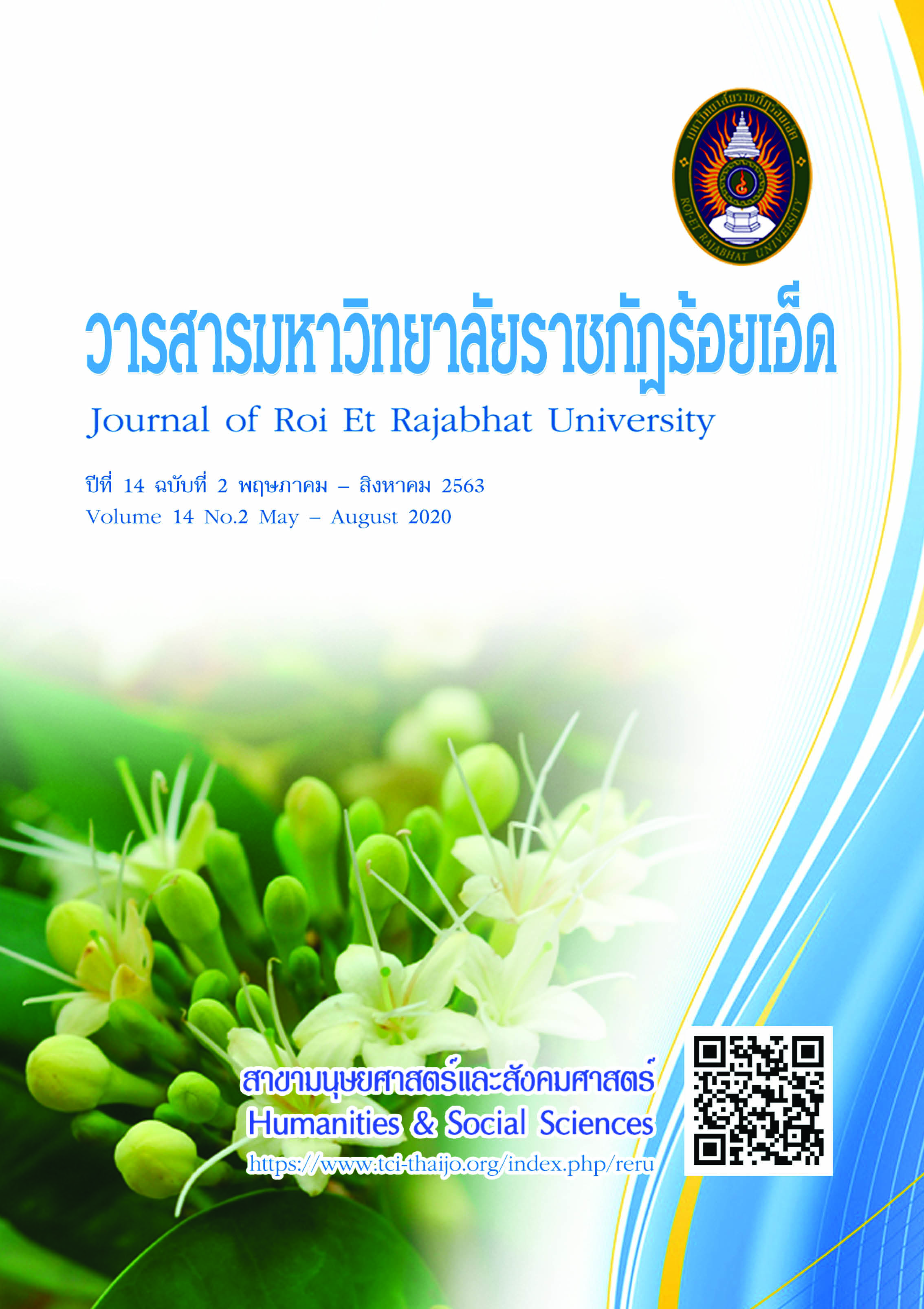Competency of Morality Ethics and Professional Law Efficacy of Nursing Student Roi Et Rajabhat University
Keywords:
ethics, code of ethics and professional law, nursing studentsAbstract
The purposes of this research study are to 1) investigate the competencies of undergraduate nursing students in ethics, code of ethics, and professional law both inclusively and distinctively, 2) compare the three competencies classified by year of study, grade point average, and parent professions, and 3) compare the three expected with the actual competencies of nursing students, Faculty of Nursing, Roi Et Rajabhat University. The population included all 299 undergraduate nursing students. The 144 subjects were drawn proportionately with the year of study and selected by using a table of random number. The instrument employed to assess the three competencies for nursing students was adopted from Chantamungkhun and others (2019) with the discrimination index of .94-.99 and .94 for the reliability. Data were analyzed using mean, standard deviation, one-way ANOVA and paired sample t-test. The findings indicated that 1) the nursing students obtained a high to a very high level of competencies in ethics, code of ethics, and professional law both inclusively and distinctively. The highest competency was in professional law followed by code of ethics and ethics, respectively. 2) Comparing student competencies, the result showed that there were differences in all three competencies classified by cumulative grade point average with a statistical significance at .05 level. 3) The result also showed that there was a statistically significant difference between the mean scores of the all three expected and the actual competencies at .01 level.
References
คณะกรรมการฝ่ายพัฒนานักศึกษา. (2560). คู่มือคณะพยาบาลศาสตร์ มหาวิทยาลัยราชภัฏร้อยเอ็ด. ร้อยเอ็ด: มหาวิทยาลัยราชภัฏร้อยเอ็ด.
จริยา กฤติยาวรรณ. (2559). ปัจจัยที่มีความสัมพันธ์กับพฤติกรรมเชิงจริยธรรมตามจรรยาบรรณวิชาชีพพยาบาล ของนักศึกษาพยาบาล คณะพยาบาลศาสตร์ มหาวิทยาลัยราชธานี. การประชุมวิชาการและเสนอผลงานวิจัยระดับชาติ ราชานีวิชาการครั้งที่ 1 “การสร้างเสริมสหวิทยากา ผสมผสานวัฒนธรรมไทย ก้าวอย่างมั่นใจสู่ AC”. วันที่ 29 กรกฎาคม 2559. อุบลราชธานี: มหาวิทยาลัยราชธานี. 1661-1674.
จุลจีรา จันทะมุงคุณ, ณัฐิกา ราชบุตร, ช่อทิพย์ แตงพันธ์ และเขมิกา เสียงเพราะ. (2562). การสร้างแบบสมรรถนะด้านจริยธรรม จรรยาบรรณ และกฎหมายวิชาชีพสำหรับนักศึกษาพยาบาล : มหาวิทยาลัยราชภัฏชัยภูมิ. วารสารวิชาการมหาวิทยาลัยราชภัฏเพชรบุรี, 9(2), 132-143.
ทองจันทร์ หงศ์ลดารมภ์. (2560). จริยธรรมแห่งวิชาชีพและจริยศาสตร์. สืบค้นเมื่อ 20 ธันวาคม 2562, จาก http://www.stc.arts.chula.ac.th/Publications/files/Professional_ethics
บุญใจ ศรีสถิตย์นรากูร. (2553). ระเบียบวิธีการวิจัยทางพยาบาลศาสตร์ (พิมพ์ครั้งที่ 5). กรุงเทพฯ: ยูแอนด์ไอ อินเตอร์มีเดีย.
บุญชม ศรีสะอาด. (2542). วิธีการทางสถิติสําหรับการวิจัย (พิมพ์ครั้งที่ 2). กรุงเทพฯ: สมควรริยาสาส์น.
บุษา จันดาทอง. (2554). ประสบการณ์การถูกร้องเรียนพฤติกรรมบริการของพยาบาลวิชาชีพ. สืบค้นเมื่อ 20 ธันวาคม 2562, จาก http://cuir.car.chula.ac.th/handle/123456789/45310
พรจันทร์ สุวรรณชาต. (2552). พยาบาลกับการประกอบวิชาชีพที่อาจถูกฟ้องร้องได้. วารสารการพยาบาล, 24(2), 11-13.
พรศิริ พันธสี และเจตจรรยา บุญญกูล. (2560). ปัจจัยที่มีผลต่อพฤติกรรมเชิงจริยธรรมและการปฏิบัติตามกฎหมาย ในการปฏิบัติการพยาบาลของนักศึกษาพยาบาล. วารสารพยาบาลสภากาชาดไทย, 10(1), 81-94.
วริยา ชินวรรโณ. (2558). จริยธรรมในวิชาชีพ. นครปฐม: สำนักพิมพ์มหาวิทยาลัยมหิดล.
วิริยาภรณ์ แสนสมรส, วิภารัตน์ ยมดิษฐ์ และนพวรรณ ดวงจันทร์. (2560). คุณธรรมจริยธรรมของนักศึกษาพยาบาล : กรณีศึกษาวิทยาลัยพยาบาลบรมราชชนนี ราชบุรี. วารสารการพยาบาลและการศึกษา, 10(4), 104-159.
วันเพ็ญ บุญปะกอบ. (2555). หลักของเวชจริยศาสตร์. กรุงเทพฯ: โรงพิมพ์เดือนตุลา.
สิวลี ศิริไล. (2556). จริยศาสตร์สำหรับพยาบาล (พิมพ์ครั้งที่ 13). กรุงเทพฯ: สำนักพิมพ์แห่งจุฬาลงกรณ์มหาวิทยาลัย.
Berry, A. J. (2009). Nurse practitioner/patient communication styles in clinical practice. Journal for Nurse
Practitioners, 5(7), 508-514.
Downloads
Published
How to Cite
Issue
Section
License
บทความที่ได้รับการตีพิมพ์เป็นลิขสิทธิ์ของวารสารมหาวิทยาลัยราชภัฎร้อยเอ็ด
ข้อความที่ปรากฏในบทความแต่ละเรื่องในวารสารวิชาการเล่มนี้เป็นความคิดเห็นส่วนตัวของผู้เขียนแต่ละท่านไม่เกี่ยวข้องกับมหาวิทยาลัยราชภัฎร้อยเอ็ด และคณาจารย์ท่านอื่นๆในมหาวิทยาลัยฯ แต่อย่างใด ความรับผิดชอบองค์ประกอบทั้งหมดของบทความแต่ละเรื่องเป็นของผู้เขียนแต่ละท่าน หากมีความผิดพลาดใดๆ ผู้เขียนแต่ละท่านจะรับผิดชอบบทความของตนเองแต่ผู้เดียว





